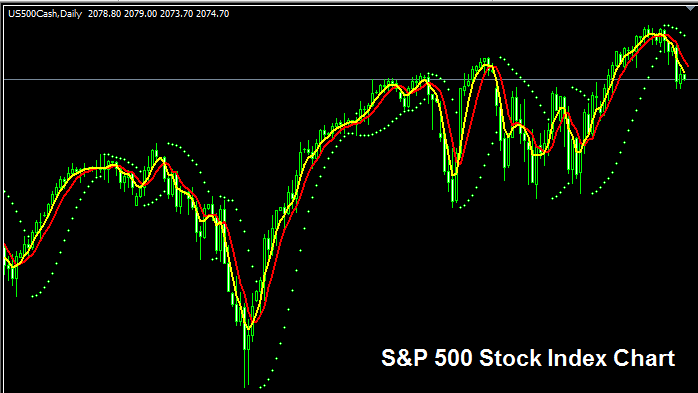S and P 500 - Standard and Poor's 500 Index
The Standard and Poor's 500 tracks the market value of 500 key stocks from major US industries. These stocks come from firms on the NYSE and NASDAQ exchanges.
The S&P 500, much like the Dow Jones Industrial Average Index, exhibits greater volatility compared to many other Top Indices. While the S&P 500 index tends toward a long-term upward trajectory, it is characterized by a higher frequency of price retracements and consolidations than other indices. Traders less inclined toward the very pronounced and strong trends observed in other leading indices might opt to trade alternatives.
One factor contributing to this stock index exhibiting greater fluctuations compared to others is its inclusion of a larger number of constituent stocks. Furthermore, the calculation methodology for this index incorporates a weighting factor, which also plays a role in increasing its inherent volatility.

The S & P 500 Chart
The S&P 500 chart appears above. This example labels it US500CASH. Find a broker offering S&P 500 charts to start trading it. The display above is S&P 500 on MT4 FX and software.
Other Info about the S & P 500 Index
Official Index Symbol - SPX:IND
The 500 companies comprising the S&P 500 are drawn from the primary sectors of the American economy. However, the methodology for deriving this stock index differs from and is compared to others: the value components/constituents of these 500 stocks are assigned a weighting factor, which imparts greater volatility to this index compared to others.
Strategy to Trading the S & P 500 Index
S&P 500 method of calculation makes it more volatile and hence there are more wide swings in the price movements of this stock index. Although this stock index in general moves upwards over long-term because America economy also shows strong and robust growth and is also the biggest/largest economy in the world.
As a trader wanting to trade this stock index, be prepared for wider price swing and a little more volatility.
In your role as a stock index trader, maintaining a positive outlook and consistently purchasing as the index ascends is beneficial. When the American economy thrives (which it often does), this upward trend is more frequently observed. An effective trading tactic for stock indices involves buying during price dips.
During Economic SlowDown and Recession
During economic slowdown & recession times, companies begin and start reporting slower revenues, lower profits and lowers growth prospects. It is because of this reason which investors/traders begin to sell shares of corporations reporting lower profits & therefore the stock index tracking these particular stocks will also start to move downward.
Therefore, during these times indices trends are likely to be heading and moving downwards and as a trader you should also adjust your strategy accordingly to fit the prevailing downwards trends of the stocks market index that you as a trader are trading.
Contracts and Specs
Margin Required Per 1 Contract - $ 12
Value per 1 Pip(Point) - $ 0.1
NB: The main trend points up overall. As a trader, factor in daily market swings. Some days, stock indices range or pull back. Pullbacks can grow large sometimes. Time your entry with precision in this stock strategy. Use fitting money management rules for surprise volatility. On equity management in index lessons: What are stock index equity money management methods and index equity strategies.
Study More Tutorials & Tutorials:
- Best SX 50 Trade Strategy
- EURO STOXX Trade Strategies and EURO STOXX Strategy
- US30 Index Trading Strategy and US30 FX Trade Strategy
- How Do You Set SX 5E Index on MetaTrader 4 Software/Platform?
- Course to S & P 500 Index
- How to Calculate Pips For SPAIN 35 Index
- How Do You Set S&P ASX in MetaTrader 5 App?
- How Do You Set Nikkei 225 Index on MetaTrader 4 Platform?
- How Do You Set IT 40 on MetaTrader 4 App?

